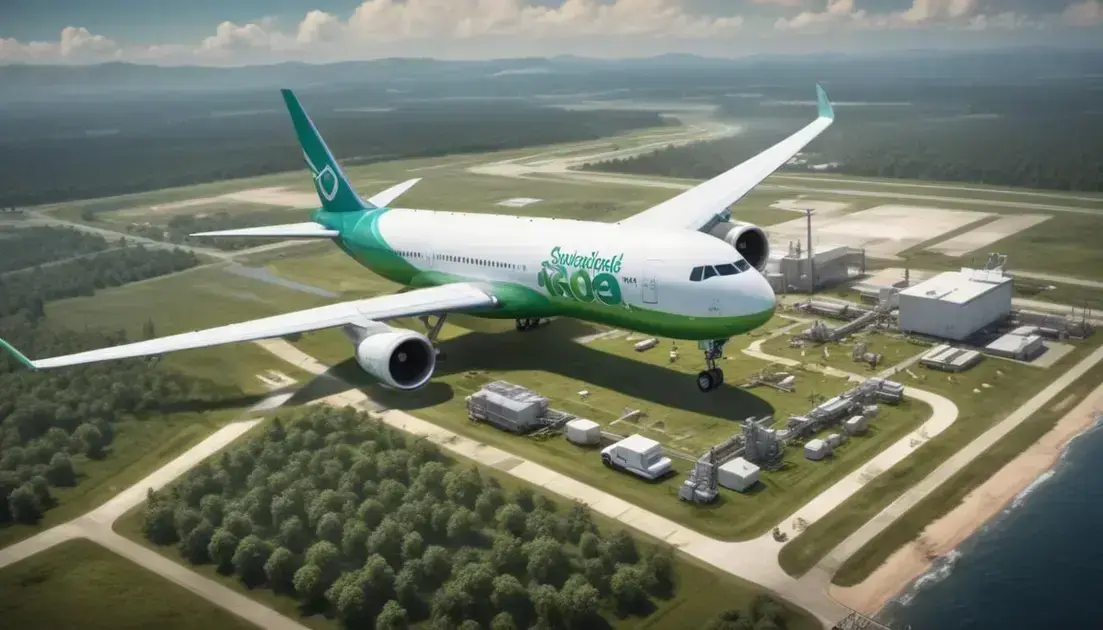IATA Launches a Decarbonisation Initiative for Aviation
Sustainable aviation fuel (SAF) significantly reduces carbon emissions in the aviation industry by utilizing renewable resources, though challenges like production costs and infrastructure need to be addressed for widespread adoption.
Sustainable aviation fuel is crucial for the future of air travel, and IATA’s new plans could transform the industry’s approach to greener flying. Curious about how this works?
The creation of CADO for aviation fuel supervision
The creation of the CADO initiative marks a pivotal step in aviation fuel supervision. This ambitious program aims to standardize the oversight of sustainable aviation fuel (SAF) by establishing comprehensive metrics and protocols. The goal is to enhance transparency and accountability across the supply chain, ensuring that SAF production meets rigorous environmental standards.
One of the key features of CADO is its focus on traceability. By implementing a robust tracking system, stakeholders can monitor the origin and environmental impact of aviation fuels. This transparency not only builds consumer trust but also encourages producers to maintain higher sustainability practices.
Furthermore, CADO will develop guidelines for assessing the overall lifecycle impacts of SAF. This type of assessment is crucial for understanding how different fuels affect carbon emissions and allied environmental factors. The initiative also seeks to promote collaboration among industry players, fostering partnerships aimed at overcoming the technical hurdles related to SAF production.
As the aviation industry strives for significant reductions in greenhouse gas emissions, initiatives like CADO are essential. They provide a structured approach to navigating the challenges of integrating sustainable solutions into conventional aviation practices, ultimately driving the sector towards a more sustainable future.
Challenges in scaling sustainable aviation fuel production
Scaling the production of sustainable aviation fuel (SAF) presents several challenges that the aviation industry must address. One of the primary obstacles is the high production costs associated with SAF. Unlike traditional jet fuels, SAF requires advanced technologies and raw materials that can significantly increase prices, making it less competitive in the marketplace.
Another challenge is the limited availability of feedstocks suitable for SAF production. Many of the organic materials required, such as used cooking oil or agricultural residues, are not widely available in sufficient quantities. This scarcity can hinder efforts to boost SAF output and may lead to competition for these resources.
Moreover, the existing infrastructure for fuel distribution is not fully equipped to handle large quantities of SAF. Upgrades and investments in new technologies are necessary to ensure that SAF can be efficiently transported and integrated into the current fuel supply chain.
Regulatory hurdles also impact the speed of SAF adoption. Policymakers are still developing the frameworks needed to facilitate broader usage of SAF while ensuring environmental standards are met. Navigating this regulatory landscape can delay the scaling process, posing an additional challenge for the industry as it seeks to transition toward more sustainable fuel alternatives.
The role of the SAF Registry in aviation decarbonisation
The SAF Registry plays a crucial role in aviation decarbonization efforts by providing a centralized platform for tracking and verifying sustainable aviation fuels (SAF). This registry ensures that the production and use of SAF are transparent and accountable, which is essential for achieving sustainability goals in aviation.
One of the key functions of the SAF Registry is to monitor the lifecycle emissions of SAF from production to consumption. By documenting this data, stakeholders can assess the environmental benefits of using SAF compared to traditional fossil fuels. This comprehensive approach is vital in demonstrating the effectiveness of SAF in reducing carbon footprints.
Moreover, the SAF Registry serves as a vital tool for regulatory compliance. It facilitates adherence to government regulations and industry standards, ensuring that SAF producers and users meet environmental criteria. This compliance fosters trust among consumers and investors, who are increasingly concerned about sustainability.
Additionally, the registry encourages innovation by providing a framework for new SAF technologies. By tracking advancements and sharing best practices, the SAF Registry promotes collaboration among industry players, driving progress toward cleaner aviation solutions.
Collaborative efforts to tackle aviation emissions
Collaborative efforts are essential in addressing aviation emissions and promoting sustainable practices within the industry. Airlines, manufacturers, and governments are increasingly joining forces to develop strategies aimed at reducing the carbon footprint of air travel. Such partnerships enable the sharing of resources, knowledge, and best practices to maximize environmental benefits.
One notable initiative in this collaboration is the formation of industry coalitions dedicated to sustainability. These groups work together to create innovative solutions, such as the development of advanced sustainable aviation fuels (SAF) and improved operational efficiencies. By pooling expertise from various sectors, these coalitions can expedite the research and implementation of effective emissions-reduction technologies.
Additionally, regulatory bodies play a critical role in facilitating collaboration among stakeholders. By establishing clear policies and incentives, governments can encourage investments in greener technologies and promote commitments to emissions reduction. This collaborative approach is vital in setting achievable targets that can be monitored and assessed effectively.
Moreover, public awareness campaigns and consumer engagement initiatives help to further drive change. As travelers become more informed about the environmental impact of their choices, airlines are motivated to prioritize sustainability in their operations. In this way, collaboration not only occurs within the industry but also extends to customers and communities, fostering a holistic approach to tackling aviation emissions.
Financial accessibility and future outlook for SAF
Financial accessibility is a critical factor in the future of sustainable aviation fuel (SAF). As the industry aims to transition to greener alternatives, securing funding and investment is essential. The initial costs associated with SAF production can be high, primarily due to the advanced technologies and raw materials required. Therefore, innovative financing solutions are necessary to support the growth of SAF.
One approach to enhance financial accessibility is the establishment of public-private partnerships. These collaborations can leverage government funding and private sector expertise to develop SAF projects. Such partnerships not only provide capital but also reduce financial risks for investors, encouraging more participation.
Another promising avenue is the use of carbon credits and government incentives. By implementing policies that reward the use of SAF, governments can create a more attractive environment for investors. This system can also motivate airlines to adopt SAF, further driving demand and economies of scale.
The future outlook for SAF relies heavily on the ability to make it financially viable. As technology advances and production processes become more efficient, costs are expected to decline. With ongoing investments and supportive policies, SAF has the potential to play a significant role in achieving a sustainable aviation industry that meets global climate goals.
In Summary: The Future of Sustainable Aviation Fuel
Sustainable aviation fuel (SAF) presents a viable path towards reducing emissions in the aviation industry. Through collaborative efforts, innovative financing, and regulatory support, the transition to SAF can become a reality.
Challenges such as production costs and resource availability must be addressed, but solutions are being developed. By working together, stakeholders can overcome these obstacles and set the stage for a cleaner aviation future.
As technology advances and SAF production becomes more efficient, its role in achieving climate goals will become more significant. Investing in SAF is not just a necessity; it is an opportunity to create a sustainable future for air travel.
Ultimately, the commitment to SAF is crucial for both the environment and the aviation industry. With determination and collaboration, we can make this vision a reality.
Frequently Asked Questions
What is sustainable aviation fuel (SAF)?
Sustainable aviation fuel (SAF) is a type of fuel that reduces carbon emissions compared to traditional fossil fuels. It is produced from renewable resources and is designed to be compatible with existing aircraft engines.
Why is SAF important for the aviation industry?
SAF is crucial for the aviation industry as it helps reduce greenhouse gas emissions, supporting global efforts to combat climate change while allowing airlines to meet environmental goals.
What are the main challenges in producing SAF?
The main challenges include high production costs, limited availability of suitable feedstocks, and the need for improved infrastructure to support distribution and use.
How can collaboration benefit SAF adoption?
Collaboration among airlines, manufacturers, and governments can lead to shared resources, innovative solutions, and combined efforts in research and development, ultimately speeding up the adoption of SAF.
What role do policies play in promoting SAF?
Policies can provide incentives for SAF production and usage, making it financially attractive for airlines and investors, thus contributing to a more sustainable aviation future.
How can investments in SAF impact its future?
Investments in SAF are crucial for driving down costs and increasing production efficiency, which can make SAF a more viable option for airlines and help achieve climate targets.






